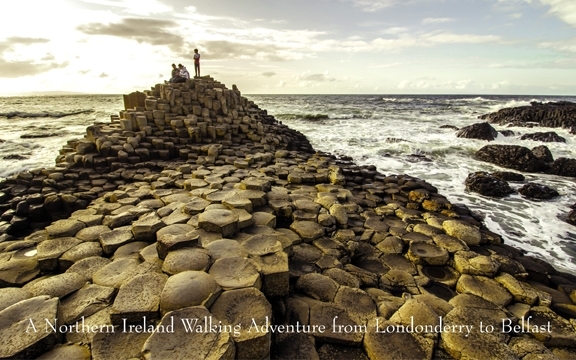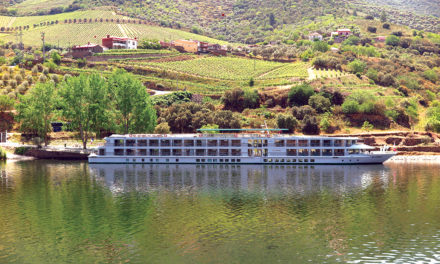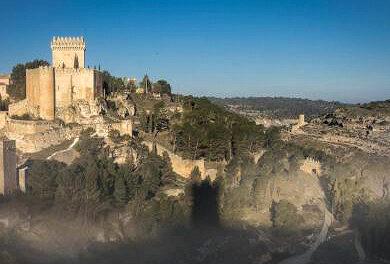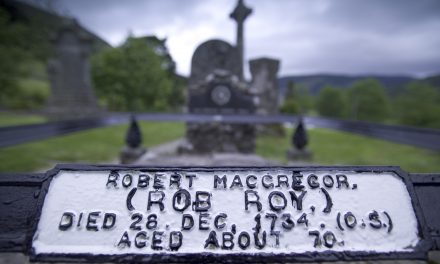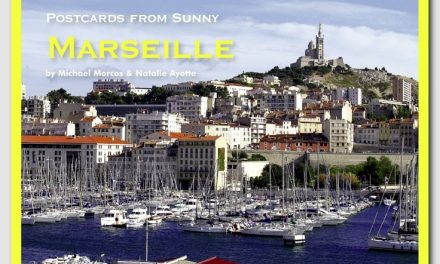Northern Ireland
Walking Adventure from Londonderry to Belfast
Article and photography by Cherie DeLory

Festivals are a good place to kick up your heels and kick off a grand travelling adven-ture. This was true for my debut visit to Northern Ireland last July to attend Ireland’s largest maritime festival, the annual Foyle Maritime Festival in Derry-Londonderry. In anticipation of my trip I was imagining myself draped in a smart Irish Fishermans sweat-er made of Aran wool in celebration of the occasion. After all, Derry-Londonderry was a host stopover port for the biennial Clipper Round the World Yacht Race 2017/’18, which coincided with the festival. I wanted to look my best while the handsome sailors were on shore leave.
Striking 70-foot yachts sailed into the Foyle Port in the final leg from New York, before heading to the finish line in Liverpool, England. I got to meet some of the sailors, climb on board for a tour of their close quarters, and soak up the excitement of the festival, which ended with the fanfare of a parade of sail and fireworks to send off the crews.
The Walled city
No visit is complete to this pretty city on a hill without “wandering the walls”. Derry-Londonderry has a small town air, but is the second largest city in Northern Ireland next to its capital, Belfast. It’s the only completely intact walled city in Ireland, totalling about a mile of atmospheric wall with vistas of the city beyond the heritage stone. I took a his-torical tour with Martin McCrossan Walled City Walking Tour. You could say it’s a city with a wee bit of an identity crisis. Some call it Derry, others say Londonderry.
Derry-Londonderry, or Derry as originally named, is the first planned city in Ireland, built between 1613 and 1619. The walls were built to protect the locals from settlers arriving from England and Scotland, and would later figure in the Great Siege of 1689. During the planning phase was when London was added to the name to reflect the Queen’s influence. Derry in year 546 was a monastic settlement founded by the Irish monk, Saint Columba, who to this day is one of three patron saints of Ireland. St. Columb’s Cathedral, circa 1633, is the oldest building in Derry-Londonderry and home to the original keys of the city gates, and has the oldest peal bells in Europe. I wish I’d heard them ring.
I stayed at the City Centre Hotel. Through my picture window I could almost reach out and touch the city’s architectural landmark, the Peace Bridge. The cycle and foot bridge connecting the Cityside and Walled City to the Waterside, over the River Foyle, opened in 2011. On the Waterside of the bridge is Ebrington Square, a former army barracks undergoing an ambitious redevelopment project, which includes a hotel and maritime museum currently under construction on listed buildings.
Maritime Heritage
This city’s maritime heritage cannot be underestimated. During World War II the city played a critical role as a navy base because of its large port that could accommodate up to 130 ships, and its proximity to the North Atlantic. But most importantly, Derry-Londonderry is known worldwide for the surrender of the German U-boat submarines.
While exploring Ebrington Square I enjoyed dinner and an eclectic craft brew flight at Walled City Brewery, the only restaurant in Ireland with a brewery, and it won Best Gas-tropub in Ireland 2017. Take time to explore the walking and cycling trails along the Riv-er Foyle, St. Columb’s Park and Heritage Trail, and get on the River Foyle for a canoe paddle with Loughs Agency, a marine and fisheries outfitter.
History told in ornate stained glass windows is a must see at the Guild Hall in the town square. It’s located at the foot of Shipquay Street, the town’s steepest street. It was even once used as a waterslide for a charity event. Browse in Craft Village, a charming cul-de-sac off of Shipquay with pastry shops, a vintage books emporium and artisan gift shops. The Diamond War Memorial, honouring the city’s fallen WW1 soldiers, stands at the top of the street where the four walled city gates can be seen from one vantage point. I couldn’t help but notice a hauntingly beautiful vacant Baroque style building which, up until 2016 when it closed its doors, was the world’s oldest independent de-partment store. Austins was open for business in 1830.
Seafood trail
During the Foyle Maritime Festival several restaurants participate in the Seafood Trail, making this the ideal time to indulge in fresh Irish catch of the day. I had a delicious smoked salmon main with a green pea puree at Thompsons Restaurant in the Derry City Hotel. At Browns in Town, I ordered an Irish staple of champs, buttery mashed po-tatoes seasoned with garlic and scallions, and hake with a green pea puree. The Beech Hill Hotel wins points for best setting. I watched a rabbit hop about in the garden while I enjoyed a delicious duck dish, with carrot and fennel soup.
The Bishop’s Gate Hotel (circa 1899) in the walled city has been elegantly restored, leaving intact Edwardian architectural nuggets such as the exquisite oak revolving door at the entrance. Service and dining in the restaurant is impeccable, making for a memo-rable last impression before heading north east to the Causeway Coast.
One of travel documentarian Michael Palin’s recommendations for Great Railway Jour-neys of the World is the route from Derry-Londonderry to Colleraine. Given that there’s something about train travel that’s irresistible to me, I booked my ticket on the Translink and was on my way to the seaside resort town of Portrush, earmarked as host town of next summer’s 2019 Open Championship. The Royal Portrush Golf Club’s Dunluce Links is considered one of the best in the world.
Barefoot in Bushmills
I stayed at the Royal Court Hotel on the outskirts of town, with dreamy views of the ocean. Without a car, I could take a five-minute taxi, bus, or a 45-minute stroll into town along Whiterocks Beach, which was the beginning of a memorable experience exploring the Causeway Coast.
I purchased a Translink day pass bus ticket and Dunluce Castle was my first stop. You can walk amidst the atmospheric ruins, situated high on a cliff overlooking the sea. I took a winding staircase up one of the towers to a lookout and was so caught up in the maze of masonry that I missed my bus. As I was waiting for the next bus a women’s walking group persuaded me to join them part way. They assured me that I would be able to continue my journey to Giant’s Causeway on foot. I’m an active person and avid cyclist, so this was a challenge I was prepared to take on. I was a tad weary upon arri-val to the Giant’s Causeway Visitor’s Centre about three hours on, but thrilled with my adventure. I had a unique perspective, walking barefoot along the shoreline, a picnic lunch, ascending nature trails alongside the cliff’s edge, stopping to stare at cows graz-ing in the field; one that very few can say they’ve experienced, judging by the bus loads of tourists.
Next stop was a hop, skip and a swig to the oldest whiskey distillery in the world, Old Bushmills Distillery. (Ask about the Giant’s Causeway and Bushmills Heritage Railway as a travel option.) Then to Portrush for dinner and some entertaining summer stock theatre at the Portrush Town Hall. Needless to say, I slept well.
A day in Belfast
The next day I was off to Belfast via the train for my final day in Northern Ireland. I checked in at the newly opened Grand Central Hotel Belfast, where panoramic views of the city surrounded by the Belfast Hills beyond can be viewed from the 23rd floor Ob-servatory Lounge. I walked everywhere, to Titanic Belfast across town, on the site of the shipyard where the RMS Titanic was built, and to the Botanic Gardens and Ulster Museum in the Queen’s Quarter near Queen’s University. Near City Hall, hidden in the basement of a heritage row house, I satisfied my indulgence for superior chocolate with a visit to Co Couture, an award winning small-batch chocolatier that uses organic cacao sourced from Madagascar. I needed more than a day to enjoy this beautiful city. So many reasons to return to Northern Ireland.
www.discovernorthernireland.com
Click on cover to view published article

